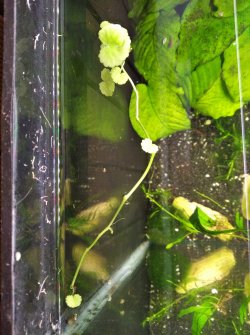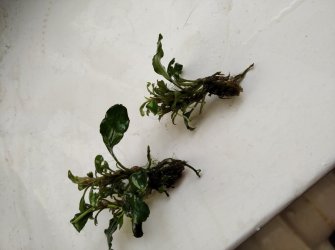Leave the pennywort to float. It normally occurs in shallow water where the roots are wet and the leaves are at the surface or just above the surface.
You can leave the Bucephlandra to float until it grows bigger (assuming it does).
How long are the tank lights on for?
Do you add any fertiliser to the tank?
Do you add carbon dioxide (CO2) to the tank?
---------------------
AQUARIUM PLANTS 1.01
LIGHTING TIMES
Most aquarium plants like a bit of light and if you only have the light on for a couple of hours a day, they struggle. If the light doesn't have a high enough wattage they also struggle. Try having the tank lights on for 10-12 hours a day.
If you get lots of green algae then reduce the light by an hour a day and monitor the algae over the next 2 weeks.
If you don't get any green algae on the glass then increase the lighting period by an hour and monitor it.
If you get a small amount of algae then the lighting time is about right.
Some plants will close their leaves up when they have had sufficient light. Ambulia, Hygrophilas and a few others close their top set of leaves first, then the next set and so on down the stem. When you see this happening, wait an hour after the leaves have closed up against the stem and then turn lights off.
--------------------
TURNING LIGHTS ON AND OFF
Stress from tank lights coming on when the room is dark can be an issue. Fish don't have eyelids and don't tolerate going from complete dark to bright light (or vice versa) instantly.
In the morning open the curtains or turn the room light on at least 30 minutes (or more) before turning the tank light on. This will reduce the stress on the fish and they won't go from a dark tank to a bright tank instantly.
At night turn the room light on and then turn the tank light off. Wait at least 30 minutes (or more) before turning the room light out. This allows the fish to settle down for the night instead of going from a brightly lit tank to complete darkness instantly.
Try to have the lights on at the same time each day. Use a timer if possible.
--------------------
LIST OF PLANTS TO TRY
Some good plants to try include Ambulia, Hygrophila polysperma, H. ruba/ rubra, Elodia (during summer, but don't buy it in winter because it falls apart), Hydrilla, common Amazon sword plant, narrow or twisted/ spiral Vallis, Water Sprite (Ceratopteris thalictroides/ cornuta).
The Water Sprite normally floats on the surface but can also be planted in the substrate. The other plants should be planted in the gravel.
Ambulia, H. polysperma, Elodia/ Hydrilla and Vallis are tall plants that do well along the back. Rotala macranda is a medium/ tallish red plant that usually does well.
H. ruba/ rubra is a medium height plant that looks good on the sides of the tank.
Cryptocorynes are small/ medium plants that are taller than pygmy chain swords but shorter than H. rubra. They also come in a range of colours, mostly different shades of green, brown or purplish red. Crypts are not the easiest plant to grow but can do well if they are healthy to begin with and are not disturbed after planting in the tank.
Most Amazon sword plants can get pretty big and are usually kept in the middle of the tank as a show piece. There is an Ozelot sword plant that has brown spots on green leaves, and a red ruffle sword plant (name may vary depending on where you live) with deep red leaves.
There is a pygmy chain sword plant that is small and does well in the front of the tank.
--------------------
TRUE AQUATIC VS MARSH/ TERRESTRIAL PLANTS
Lots of plants are sold as aquarium plants and most are marsh plants that do really well when their roots are in water and the rest of the plant is above water. Some marsh plants will do well underwater too.
Hair grass is not a true aquatic plant, neither is Anubias.
Some common marsh plants include Amazon sword plants, Cryptocorynes, Hygrophila sp, Rotala sp, Ludwigia sp, Bacopa sp. These plant do reasonably well underwater.
True aquatic plants include Ambulia, Cabomba, Hornwort, Elodia, Hydrilla and Vallis.
The main difference between marsh plants and true aquatic plants is the stem. True aquatics have a soft flexible stem with air bubbles in it. These bubbles help the plant float and remain buoyant in the water column.
Marsh plants have a rigid stem and these plants can remain standing upright when removed from water. Whereas true aquatic plants will fall over/ collapse when removed from water.
--------------------
IRON BASED PLANT FERTILISER
If you add an iron based aquarium plant fertiliser, it will help most aquarium plants do well. The liquid iron based aquarium plant fertilisers tend to be better than the tablet forms, although you can push the tablets under the roots of plants and that works well.
You use an iron (Fe) test kit to monitor iron levels and keep them at 1mg/l (1ppm).
I used Sera Florena liquid plant fertiliser but there are other brands too.
--------------------
CARBON DIOXIDE (CO2)
There is no point adding carbon dioxide (CO2) until you have the lights and nutrients worked out. Even then you don't need CO2 unless the tank is full of plants and only has a few small fish in.
There is plenty of CO2 in the average aquarium and it is produced by the fish and filter bacteria all day, every day. The plants also release CO2 at night when it is dark. And more CO2 gets into the tank from the atmosphere.
Don't use liquid CO2 supplements because they are made from toxic substances that harm fish, shrimp and snails.



